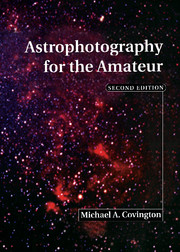Book contents
- Frontmatter
- Dedication
- Contents
- Preface
- Notes to the reader
- Symbols usued in formulae
- I SIMPLE TECHNIQUES
- II ADVANCED TECHNIQUES
- III PHOTOGRAPHIC TECHNOLOGY
- IV DIGITAL IMAGING
- APPENDICES
- A Exposure tables
- B Mathematical analysis of polar-axis misalignment
- C Plans for an electronic drive corrector
- D Film data
- E Photographic filters
- F Organizations and resources
- Bibliography
- Index
B - Mathematical analysis of polar-axis misalignment
Published online by Cambridge University Press: 05 September 2013
- Frontmatter
- Dedication
- Contents
- Preface
- Notes to the reader
- Symbols usued in formulae
- I SIMPLE TECHNIQUES
- II ADVANCED TECHNIQUES
- III PHOTOGRAPHIC TECHNOLOGY
- IV DIGITAL IMAGING
- APPENDICES
- A Exposure tables
- B Mathematical analysis of polar-axis misalignment
- C Plans for an electronic drive corrector
- D Film data
- E Photographic filters
- F Organizations and resources
- Bibliography
- Index
Summary
If the polar axis of an equatorial mount is misaligned, three kinds of errors result:
• Hour angle error (the object appears to drift in right ascension, or putting it another way, the drive rate appears to be wrong);
• Declination error (the object appears to drift in declination);
• Field rotation (the object appears to rotate). The hour angle error is entirely absorbed into guiding corrections that are needed for other reasons. In this appendix I shall analyze the remaining two. As far as I can determine, no one in the twentieth century has published a full analysis of this matter, although it is discussed by Chauvenet (1876, vol. 2, pp. 367–390) and Pickering (1886, pp. 195–201). Their equipment was quite different from that now in use, and their aim was to build perfect equatorial mounts rather than to analyze the effect of making guiding corrections with portable equipment whose alignment is never perfect. On the related problem of tracking the stars with an altazimuth mount and field-de-rotator, see Trueblood and Genet (1985, p. 109 ff.) and Pouplier (1992).
Precaution for calculators Many of the calculations described here require a large number of significant digits in order to yield useful results. For example, in Example 1, a number is multiplied by 0.999 990 480 7, and if this were rounded to 1.0 the entire significance of the number would be lost.
- Type
- Chapter
- Information
- Astrophotography for the Amateur , pp. 276 - 282Publisher: Cambridge University PressPrint publication year: 1999



